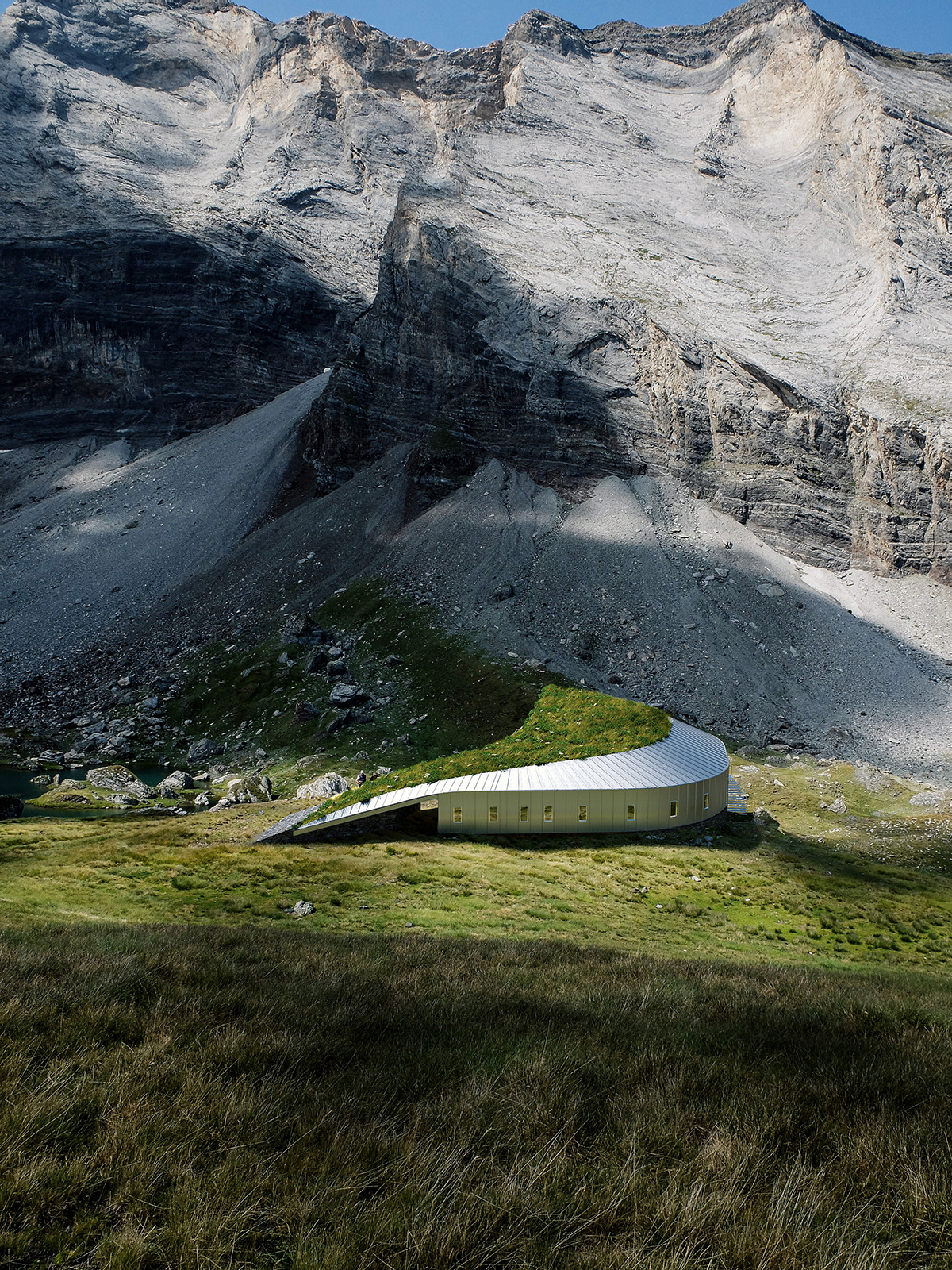Snøhetta announces Refuge de Barroude
A safe haven for hikers in the Pyrenees
Nestling in a UNESCO World Heritage site in the heart of the Pyrenees National Park, the project to rebuild the Barroude mountain refuge follows the accidental fire that destroyed the old refuge ten years ago. The building will provide a new stop-off point for hikers on the Haute Route des Pyrénées, as well as a new reception and support centre for National Park staff.
Designed in a sober and yet modern way to preserve the fauna and flora of the Pyrenees national Park, the new refuge will welcome hikers while limiting the building’s environmental footprint on the Cirque de Barroude natural site.
The general layout is based around two main functional areas. On the one hand, a set of areas open to the public, including the reception areas, dining room, toilets and dormitories, and on the other, a set of private areas reserved for the refuge warden and the staff of the Pyrenees national Park.
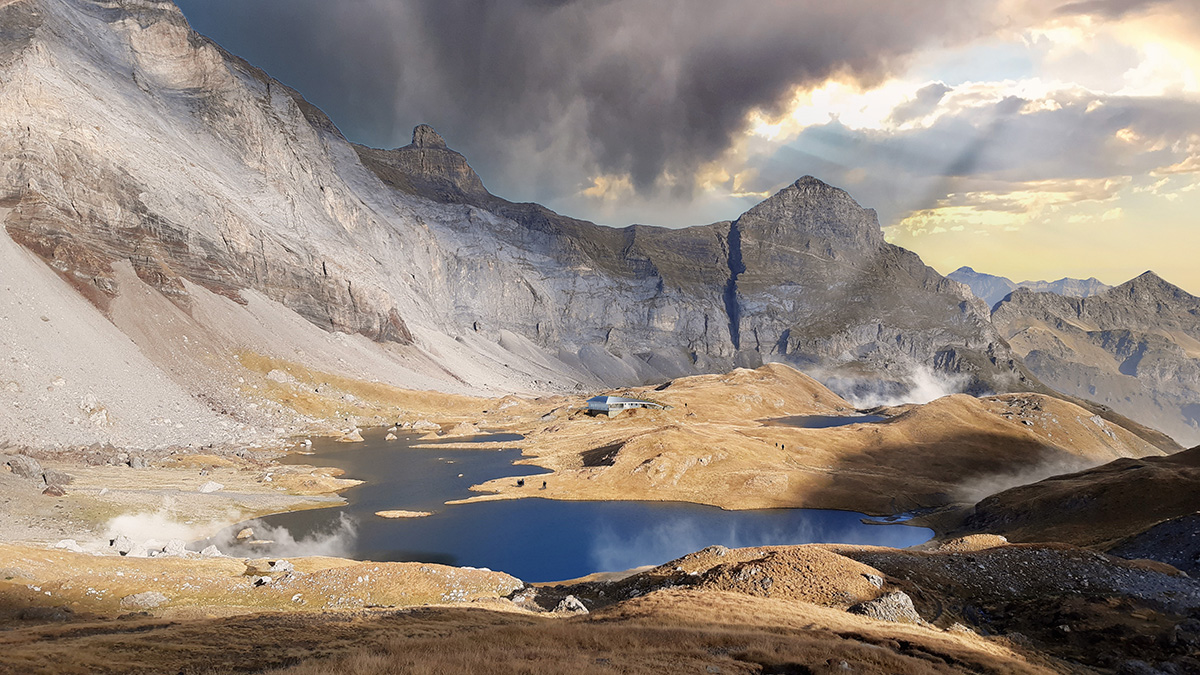
A balance between integration and visibility
The concept for the new Barroude refuge is based on the desire to provide a safe haven for hikers while preserving the integrity and majesty of its natural surroundings. In this grandiose setting, where the human presence must remain humble, the project’s concept strikes a delicate balance between integration and visibility.
This conceptual approach is based on two key words, the Terrier and the Cairn.
The first evokes integration, warmth and security. The second a destination, a landmark built from the natural elements of the mountains.
These two words come together and complement each other in an architecture that appears to curl up in the thicknesses of the topography and landscape, but whose materiality of stone, wood and aluminium provides a contrast that signals a protective haven in the heart of the Pyrenean peaks.
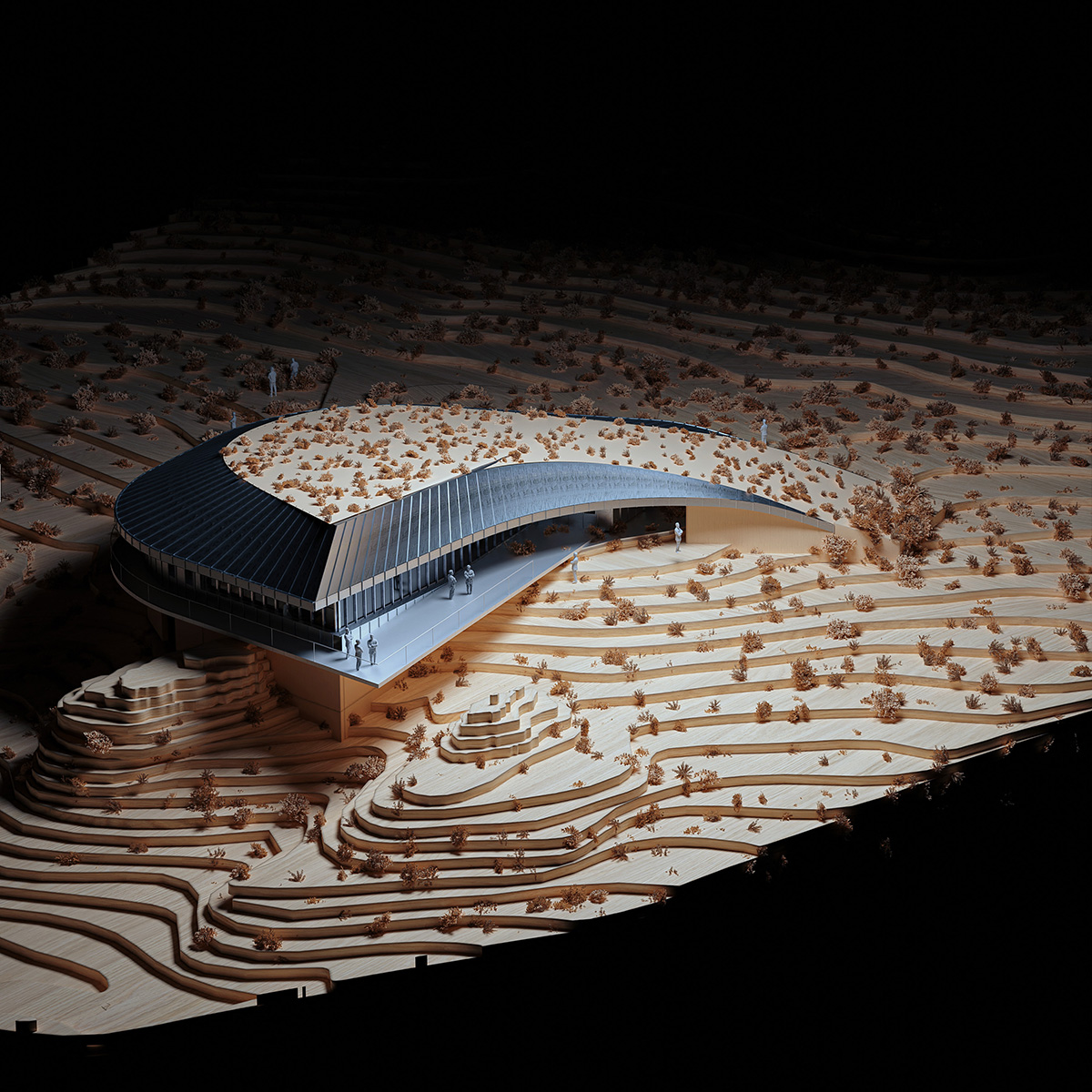
Adapted to its surrounding
Situated on the site of the former refuge, the building is located outside the zones where the endemic flora and fauna are protected. The position was carefully chosen to take advantage of the existing topography, enabling two levels of refuge to be created without the need for excessive earthworks.
With its bioclimatic architectural design, the refuge is a compact structure that minimises the amount of facade exposed to the elements and blends perfectly into the landscape of the Barroude cirque. The building’s dual orientation also encourages natural ventilation.
The refuge is characterised by its large planted roof, which follows the lines of the landscape, and its protective envelope made of recycled aluminium, which shelters the outside spaces from the prevailing winds.
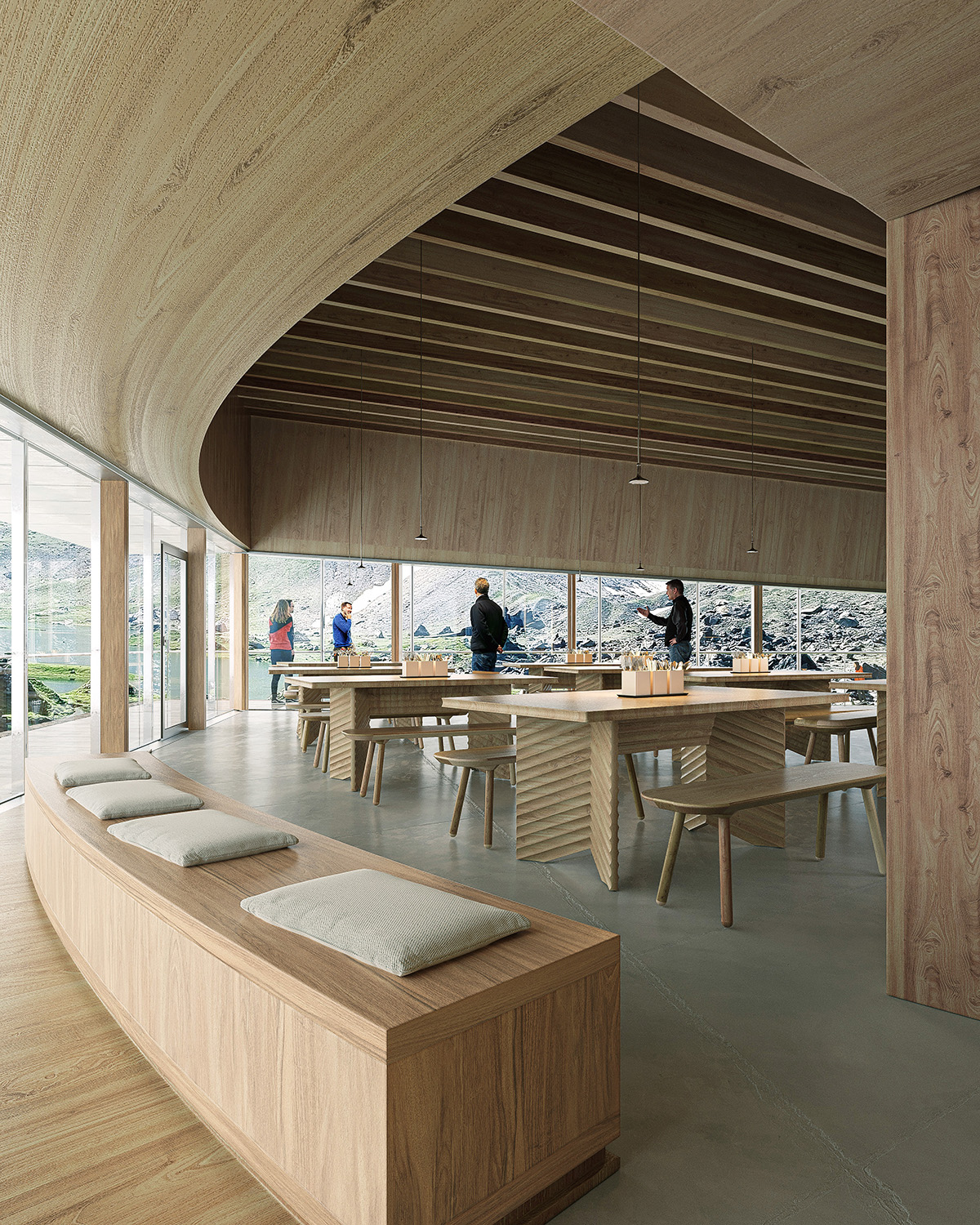
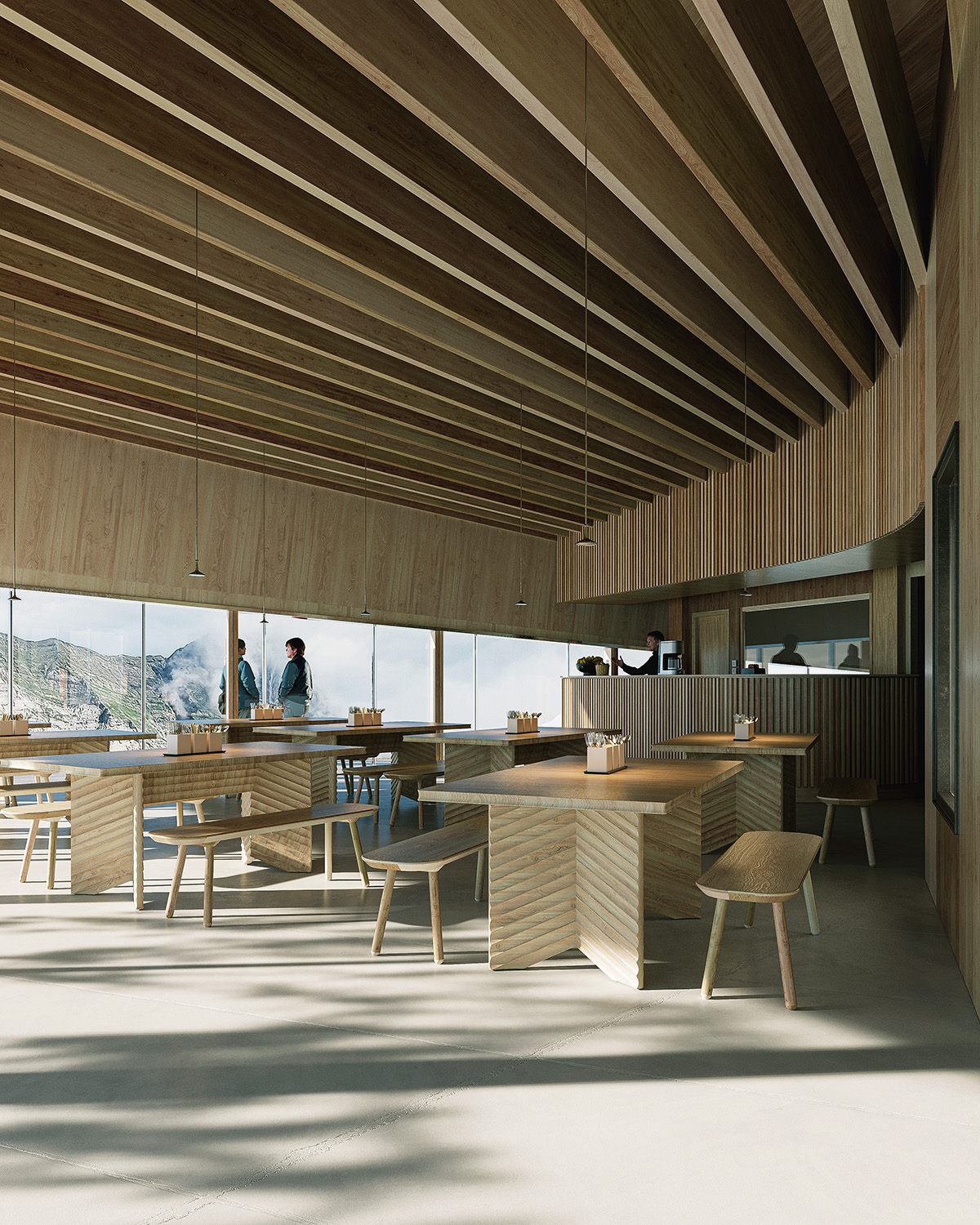
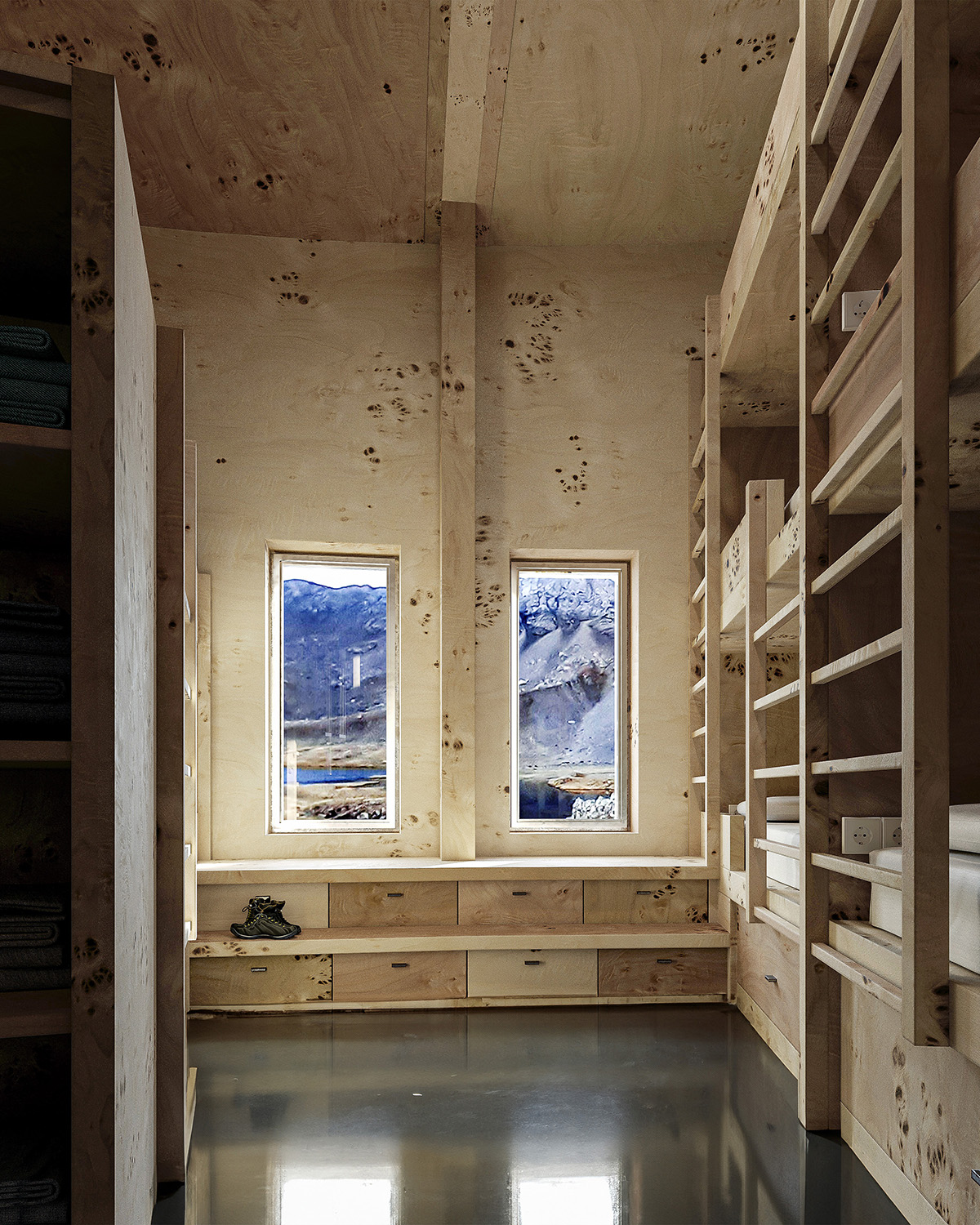
Shared spaces
The layout of the refuge is organised into two main areas: the living spaces, open onto the cirque surroundings and Lake Barroude, and the bedrooms, positioned to the north, facing the ridge. This layout makes it possible to manage the degree of privacy of the site, with a progression from the most open, the communal areas such as the the dining hall and kitchen, to the most protected, the dormitories for hikers and wardens.
The dormitories at the Barroude refuge offer several types of accommodation. The winter dormitory, on the lower ground floor with direct access from outside, is exclusively for hikers and Park staff spending the night at the refuge.
For hikers, there are 8- and 6-person dormitories, as well as 8-person dormitories adapted for winter use, each offering compact but cosy accommodation.
In addition to the hikers’ dormitories, the refuge has rooms for the warden, his assistants and Park maintenance staff.
The design of the interior spaces encourages ‘living together’ by offering a friendly, light-filled environment with views of the wider landscape.
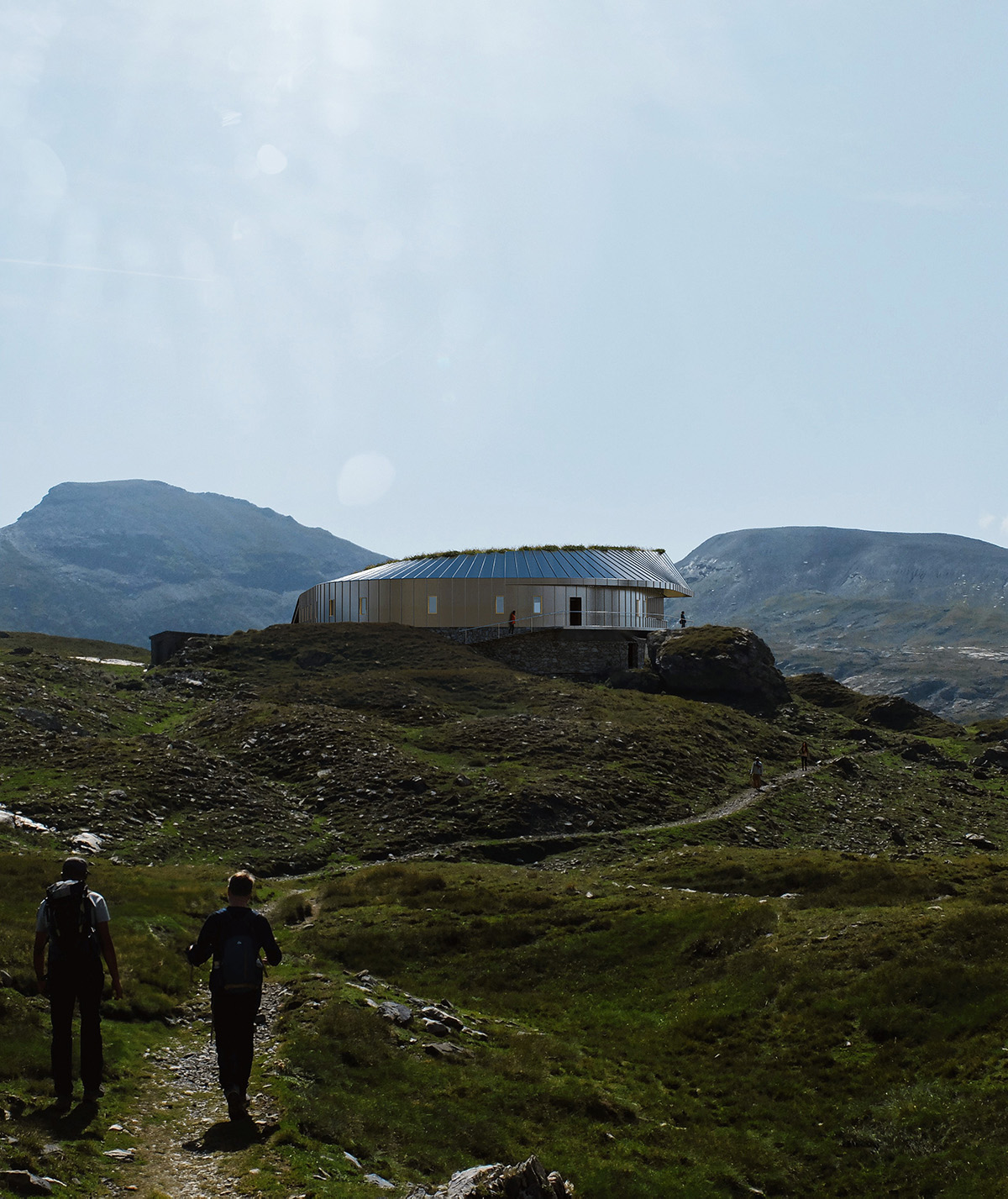
A reduced footprint
The shelter’s shell and structure are made of recycled wood and aluminium respectively. The aim is not only to promote the use of low-carbon materials, but also to maximise the prefabrication of the structure, thereby reducing the weight, on-site installation and helicopter rotations required to transport the materials.
On-site earthworks and concrete foundations are also kept to a minimum, as the structure ‘skims’ the existing ground. Not only does this mean that the structure can be fully reversed and optimally integrated into the environment, it also means that the construction period can be reduced to two seasons.
Local stone is planned for the base, ensuring perfect integration into the mountainous context and preserving the authenticity of the landscape. The choice of local stone also strengthens the link with the region and helps to reduce the carbon footprint associated with transporting materials.
The shape of the refuge is inspired by the natural contours and topography of the surrounding area. The planted roof provides an extension of the flora and fauna, while creating a fluid transition between the architecture and the mountain landscape, where the lines of the refuge merge with the natural relief, reinforcing the feeling of unity with nature.
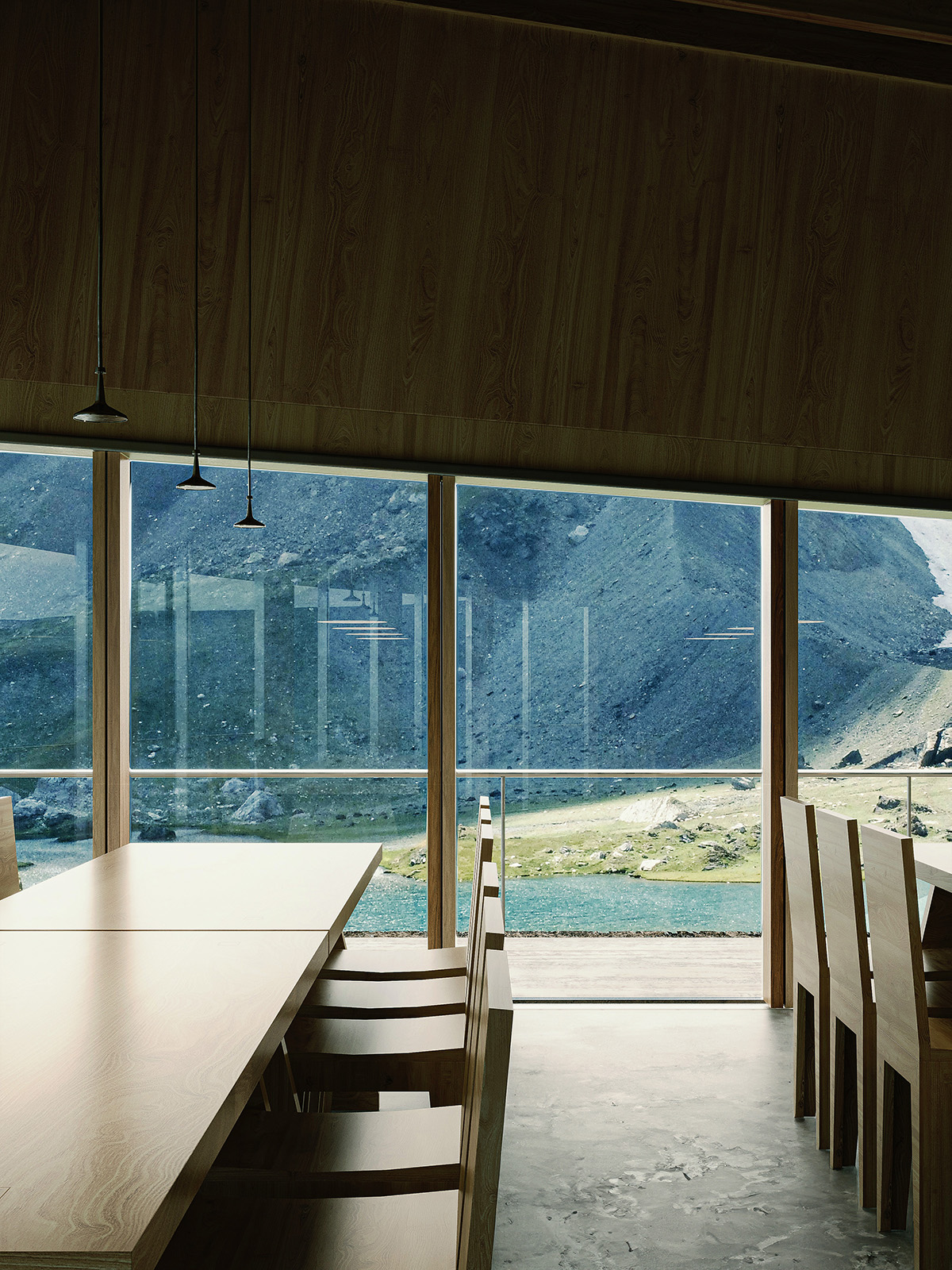
The compactness of the building is also a key factor in reducing its carbon footprint. By limiting the building’s physical footprint, the refuge minimises energy consumption for heating and cooling, while preserving the surrounding natural environment.
Efficient energy management is also built into the design. Solar and biomass heating and hot water systems are installed to reduce reliance on fossil fuels and minimise greenhouse gas emissions. In addition, the use of photovoltaic panels to produce renewable electricity helps to reduce the refuge’s carbon footprint.
Drinking water is supplied by a tank storing water from a nearby spring, and waste water is treated by infiltration, with no impact on the environment.
The next phases of the project will begin in 2025.
Dates: 2024—2027
Disciplines: Architecture, landscape & Interior
Localisation: Parc national des Pyrénées, France
Typology: Refuge
Size: 540 m2
Status: Competition won in May 2024
Client: Parc national des Pyrénées
Mechanical engineer: Energeco
Structural engineer and Façade consultant: Bollinger + Grohmann
Cost estimation: Vernet Eco
Civil engineer: Prima Ingénierie
Read more about the project on Snøhetta’s website:
https://www.snohetta.com/news/snohetta-announces-refuge-de-barroude
More news from Snøhetta:

Aura Collection: Snøhetta x Viabizzuno = Shaping the Invisible
Aura Collection: Snøhetta x Viabizzuno Shaping the Invisible: A Luminous Evolution The Aura Collection marks …

Joslyn Art Museum - A redesign for Omaha’s premier cultural hub for the visual arts by Snøhetta
Photo: Nic Lehoux After a closure of two years, The Joslyn Art Museum reopens today …
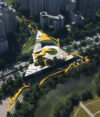
Snøhetta created an “ecological playscape” along Seoul’s dormant Banpo waterfront
Snøhetta went to the final round in the international design competition of Banpo-Hangang River Connection …
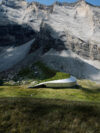
540 Square Meters of Harmony: Modern Architecture Embraces UNESCO Heritage by Snøhetta
Snøhetta announces Refuge de Barroude A safe haven for hikers in the Pyrenees Nestling in …

Čoarvemátta: New Hub Blends Sami Culture with Traditional Architecture by Snøhetta, together with 70°N architecture & artist Joar Nango
New cultural and educational hub Čoarvemátta draws inspiration from Sami heritage and traditional building customs …

Snøhetta unveils a peaceful sanctuary overlooking Japan’s famous Mount Yotei
Photo by: Mir. Rusutsu, Japan—Snøhetta has designed a new model for a vacation home nestled …

Vertikal Nydalen by Snøhetta wins Storebrand Eiendom’s sustainability award
The award was presented on Tuesday, August 13, during an event aboard the Storebrand RS, …
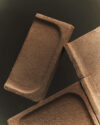
Snøhetta explores the textures of terracotta in a new tile collection with Fornace Brioni
In a second collaboration with Italian ceramic tile manufacturer Fornace Brioni, Snøhetta explores terracotta as …
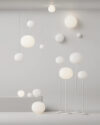
Snøhetta has extended the Volum collection with four new floor variants – Lodes
Snøhetta extends Volum series for Lodes As a continuation of the successful collaboration with Italian …
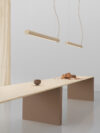
SuperDuperTube from hemp to lamp design by Snøhetta – ateljéLyktan
From hemp to lamp More than just an evolution of our classic luminaire, the Supertube, …

TraceLess Innovative cottages with low footprint by Snøhetta
Is it possible to build cottages without ruining nature? The new concept TraceLess by Snøhetta …

Snøhetta & Vipp unveils nest-like cabins on the edge of Lysefjorden
Snøhetta has been working with local entrepreneur Tom Bjarte Norland and Danish interior brand Vipp …

Snøhetta designs urban farm in the heart of Hong Kong
Snøhetta has designed three clubhouses for The Pavilia Farm residential development, creating a calming green …
Westchester Square Library Will be Snøhetta’s Latest Project with the New York City Department of Design & Construction
Last week, Snøhetta, the New York City Department of Design and Construction, and the New …

A new public Garden and a repositioned landmark debut in Midtown Manhattan by Snøhetta
A new public Garden and a repositioned landmark debut in Midtown Manhattan This week Olayan …

Snøhetta designs stars for the Norwegian Cancer Society’s 10th anniversary Christmas Star Campaign
Every Christmas, the Norwegian Cancer Society raises money for lifesaving cancer research through their Christmas …

Summit is an investigation into how a cushioned hillside, with its gentle elevation, can create intimate sharing spaces for people by Snøhetta – +Halle
Summit Modules Every so often a new piece of furniture is created, adhering to principles …

Snøhetta has designed its very first lamp collection Svit – ateljé Lyktan
SVIT Table/Floor/Wall Design by Snøhetta A piece of Scandinavian nature Snøhetta has designed its very …

Perspektivenweg by Snøhetta Wins Dezeen Awards’ Landscape Project of the Year by Public Vote
We are excited to announce that our Path of Perspectives project, Perspektivenweg, has been named …

Casework collection is growing by Snøhetta – Erik Jørgensen
The Casework collection, a collection revolving around sustainable thinking, created in collaboration with Norwegian architecture …

Casework by Snøhetta – Erik Jørgensen
Sustainability, Minimalism, Customisable. This became the refrain in the process of creating the furniture pieces …

Architecture and Landscape in Norway
Finissage of the exhibition “Architecture and Landscape in Norway – Photographs by Ken Schluchtmann” with …

Europe’s very first underwater restaurant “under” by Snøhetta
At the southernmost point of the Norwegian coastline by the village of Båly, Snøhetta has …
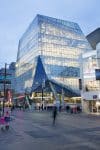
Snøhetta – Ryerson wins 2017 Toronto Urban Design Award
The Ryerson University Student Learning Centre has been selected for a 2017 Toronto Urban Design …

Snøhetta heads for completion in Saudi
Featuring an auditorium, library, cinema, exhibition hall and museum this centre for World Culture will …

Snøhetta completes landscape design for MAX IV Laboratory
Since 2011, Snøhetta has been working on the development of a unique landscape design for …
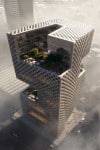
Snøhetta has won a competition to design the new Banque Libano Francaise
Snøhetta to design Banque Libano Francaise’s new headquarters Snøhetta has won the competition to design …

New San Francisco Museum of Modern Art designed by Snøhetta
The transformed and expanded San Francisco Museum of Modern Art (SFMOMA) opens to the public …

Snøhetta and OMA to Stockholm Design Talks
Stockholm Furniture & Light Fair’s own forum for knowledge and discussions in the area of …

Snøhetta @ Danish Architecture Centre 2015
19 June 2015 – 27 September 2015 The summer of 2015 the Danish Architecture Centre …

Våg bicycle roof by Snøhetta Architects – nola
Våg (Wave) is a new, modern bicycle roof in fiberglass, developed new MAX IV Laboratory …

Kick Off – NY Design Week
NYCxDESIGN is New York City’s inaugural citywide event to showcase and promote design of all …

